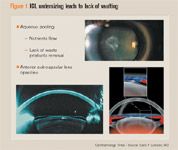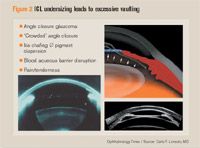Article
Echographic intraocular biometry preferred for sizing IOLs
Prevention of complications associated with implantable contact lenses requires customized sizing based on very high-frequency echography intraocular biometry. The new software, which is based on finite element analysis, is highly predictable and more accurate when compared with the white-to-white rule of thumb.

Key Points

"There is general agreement among surgeons who implant phakic IOLs that the key factor for success is the intraocular position of the lens compared with the intraocular tissues," Dr. Lovisolo said.
"For the ICL, the vault between the lens implant and the crystalline lens may depend on age but should be positioned between a minimum of 200 μm and a maximum of 750 μm," he continued. "Therefore, vault depends mainly on the lens design but also on the compression of the lens in the active position."

"Oversizing, on the other hand, may lead to excessive vaulting that may cause angle-closure glaucoma, iris chafing, pigmentary dispersion, and disruption of the blood-aqueous barrier," he said.
Although the white-on-white distance measurement is standard for sizing IOLs, Dr. Lovisolo noted that growing evidence indicates no statistical correlation between internal and external dimensions. He and his colleagues published a retrospective ultrasound study in which the data confirmed the lack of a relationship.
"We also realized that there is extreme variability in the shape of the anterior segment. Not only is there no relationship between the internal and external dimensions but also no significant correlation between the sulcus diameter and the angle diameter," he said. "In 34% of eyes, the sulcus diameter was larger than the angle, and 66% of eyes in which the sulcus to sulcus is more."
Newsletter
Don’t miss out—get Ophthalmology Times updates on the latest clinical advancements and expert interviews, straight to your inbox.




